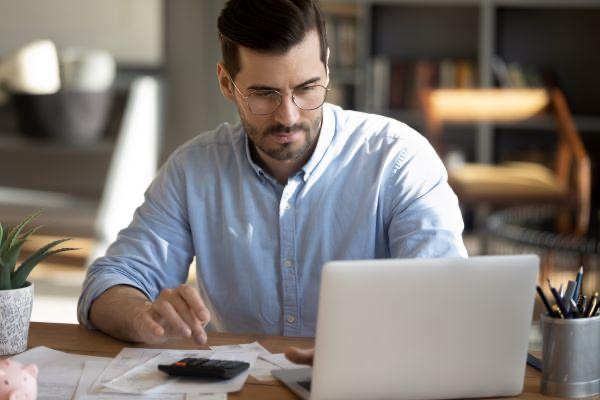Profitable Financial Planning for Optometry Practices
Part 2 of our Navigating the Business Side of Eye Care series.
Highlights
- Strategic financial planning for optometry practices is essential to help your business thrive and offer excellent patient care.
- Financial planning tasks, like expense tracking, revenue forecasting, and profit analysis, help you get organized and allocate resources effectively.
- Setting goals, creating a budget, and implementing cost management solutions can set you up for success with your patients and your finances.
- Using a digital EHR software with accounting reports and real-time dashboards can help you track your finances and plan for the short and long term.
You started in the optometry profession to provide vision care to your patients, which means delivering the newest, most advanced diagnoses and treatments. Doing so requires careful financial planning and budgeting so you can invest in new technologies and training for yourself and your staff.
Effective financial planning for optometry practices means balancing clinical work with business management, which can be difficult without the right support. For instance, lacking data on practice performance can impact resource allocation and purchasing decisions, and inefficient billing might lead to problems managing your cash flow.
To ensure the success of your optometry practice, consider these useful financial planning strategies that will assist you in staying organized and budgeting efficiently for the best business operations and excellent patient care.
In a Nutshell: The Basics of Financial Planning
Financial planning is fundamental to any business, including optometry practices. It involves strategically managing your practice’s resources to improve financial predictability, manage expenses effectively, and increase revenues for sustained stability and growth.
Financial planning typically includes the following components:
- Revenue forecasting. This involves estimating future income based on data like patient appointment trends, service pricing, and market conditions. It helps you predict how much revenue the practice can expect to generate over a given period, typically 12 months.
- Expense tracking. This is the process of systematically recording and analyzing all business expenditures. It ensures you know exactly what your practice is spending and on what, from operational costs like rent and utilities to salaries and equipment purchases. Regular tracking helps in resource allocation, showing you where you can save money on certain purchases or services.
- Profit analysis. This evaluates the practice’s overall financial health. You get a clear picture of profitability by subtracting total expenses from total revenue. This analysis lets you know where to invest in the business, how to adjust pricing, or when to cut costs for better financial performance.
Setting Financial Goals for Your Optometry Practice

Setting financial goals for your optometry practice provides purpose and direction as you grow and change. Your goals act as a roadmap for where you want your business to go in the short and long term. Outlining these objectives in an optometry business plan helps you cater to immediate operational needs while focusing on future growth and sustainability.
Short-Term Goals
Short-term goals in your optometry practice are objectives you want to accomplish within a year. They help maintain and improve daily operations, ensuring your practice runs smoothly and efficiently for better patient care and improved business processes.
Examples of short-term goals can include:
- Upgrading diagnostic equipment to provide better patient care and stay current with technological advancements.
- Implementing targeted optometry marketing strategies to attract new patients and grow your client base.
- Streamlining appointment and patient intake processes for improved patient experience and operational efficiency.
Long-Term Goals
Long-term goals in your optometry practice are strategic objectives you aim to achieve over several years. These focus on broader aspirations and major improvements, shaping the future of your practice and ensuring its long-term success and sustainability.
Examples of long-term goals:
- Expanding your services to meet patient needs by introducing new specialties or treatments, like pediatric optometry or advanced vision therapy.
- Upgrading physical space to boost patient comfort and appeal and reflect the quality of care provided.
- Using growth strategies for optometry practices, like establishing a strong reputation and community presence to continuously attract and retain patients over the years.
Creating a Realistic Budget
To develop a successful budget for your optometry practice, it’s important to plan meticulously and have a clear understanding of your financial situation. Start by estimating and categorizing your expenses, followed by formulating a strategy for projecting your revenue.
Estimating and Categorizing Expenses
Budgeting for optometry practices starts with estimating and categorizing expenses to better understand your cash flow. Use a spreadsheet or EHR software with accounting report capabilities to track the following:
- Fixed costs. These are regular, predictable expenses like rent, salaries, and insurance. Calculate these first, as they form the base of your budget.
- Variable costs. These fluctuate based on business activity. Include costs like utilities, inventory, EHR subscriptions, and marketing expenses.
- Unexpected costs. Set aside a contingency fund for unforeseen expenses like equipment repairs, investments, or sudden market pricing fluctuations in vision products.
Revenue Projection
Projecting revenue means methodically predicting future earnings by analyzing the services your business provides and current market trends.
Here’s how to approach it.
- Track historical data. Track monthly income from services like eye exams and eyewear sales and compare it to historical data from the same period. If you’re just starting out, use industry benchmarks.
- Analyze service demand. Identify which services are most popular and profitable. For example, if designer eyewear is a major revenue driver, factor this into your future projections.
- Use financial software. Use financial software or spreadsheets to record and analyze these figures. This should allow you to input different scenarios, like an increase in patients or adding a new service, and see how they impact your revenue.
- Monitor market trends. Stay informed about industry trends. For instance, if there’s a growing demand for blue light filtering glasses, consider how incorporating this into your offerings could affect income.
- Regular reviews. Regularly revisit and adjust your projections as you gather more data and as market conditions change. This helps align your financial planning with your practice’s performance and trends.
Cost Management Strategies

As part of a data-driven strategy for financial planning, focus on identifying and reducing unnecessary expenses at your practice. This streamlines your finances, enabling you to allocate your extra resources to worthwhile investments, like better equipment or marketing incentives.
Here are a few cost management strategies to consider.
Identify and Reduce Unnecessary Expenses
Analyze your current expenses to find areas where you can cut costs without compromising the quality of patient care. Pull your expense reports to identify high-cost areas or recurring charges you can eliminate or reduce.
This can include reducing office supply costs, minimizing waste, or renegotiating contracts for services such as cleaning or maintenance. By focusing on real-time financial data, you can make changes that positively impact your bottom line.
Negotiate With Suppliers and Vendors for Better Rates
Build a strong relationship with your suppliers and vendors to open the door to negotiations for more favorable pricing. Request discounts or explore alternative suppliers to find the best deals.
For instance, consider using a platform that connects you to big-name vendors like HOYA, ABB Optical Group, and CooperVision for better service and pricing. Every dollar you save on purchasing can improve your practice’s profitability.
Implement Energy-Saving Measures and Other Cost-Effective Practices
Save on expenses with energy-efficient and cost-effective behind-the-scenes strategies. If you remodel, invest in energy-efficient lighting, heating, and cooling systems. These can help you save on energy bills and yield tax benefits at the end of the year.
Consider using a cloud-based system to handle patient records and communication. This can reduce paper use and simplify your practice’s operations. With a monthly subscription, you can save on costs like hardware updates and separate fees for health records, accounting, and payment systems, all in one place.
Investing in Your Optometry Practice

Part of growing your practice means investing in new equipment, staff training, and technology. Solid financial planning requires a strategic approach to these investments, including knowing where to put your money, when, and how much return on investment (ROI) you can expect to achieve.
Ask yourself the following questions when considering long-term investments or upgrades for your practice:
- What are my main goals with this investment? For example, if you’re considering staff training programs, identify the skills you want to enhance. Consider whether the aim is to improve patient care, expand services, or boost efficiency. This will help you figure out if the investment fits with your practice’s present and future needs.
- How much ROI should I expect, and how do I measure it? For instance, if you’re adding an automated appointment scheduling system, think about the ROI you’ll see — like more time saved, fewer missed appointments, and happier patients. Consider how you’ll keep track of and evaluate these benefits, such no-show reports and patient feedback.
- How will this investment affect my practice’s finances now and in the future? Take buying a digital retinal imaging system, for example. Think about the initial cost and its immediate financial impact. Then, consider how this tool can boost your income in the long run by offering new services and being more efficient.
- Are there less expensive ways to get the same results? For instance, instead of costly in-person continuing education, online professional development courses could offer similar benefits to your team at a lower price. Evaluate the advantages and drawbacks of this cost-effective alternative.
Managing Cash Flow
A stable cash flow is crucial for your optometry business, ensuring you have the funds for day-to-day operations and long-term growth. A strong cash flow requires balancing the money coming in from patient payments and insurance reimbursements against your operational expenses.
Here are a few helpful strategies for managing accounts receivable and payable and handling cash flow gaps:
- Timely billing. Issue invoices immediately after appointments or procedures. Delays in billing can result in slow reimbursements, particularly from insurance companies, which can affect your cash flow.
- Varied payment options. Provide multiple payment methods, including credit cards, online, Apple Pay, and Google Pay. This makes it easier for patients to pay promptly.
- Regular financial reviews. Regularly assess your accounts receivable, especially insurance claims, to identify any delays or issues in payments. Stay on top of accounts payable to avoid late fees.
- Cash flow forecasting. Use forecasting tools to anticipate future cash flow, considering seasonal patient visits and eyewear purchase trends.
- Managing inventory. Keep your inventory, especially frames and lenses, lean to avoid tying up cash. Run reports that show inventory vs. sales to prevent under- or over-ordering.
- Short-term financing. To address immediate cash flow shortages, explore short-term financial solutions such as lines of credit or leasing equipment rather than buying it outright. This approach can assist in maintaining financial stability during times when business is slower.
Planning for Taxes and Retirement

Tax planning and retirement preparation are essential for optometry practice owners for personal financial security and the sustainability of the practice.
For effective tax planning, work with a tax professional to understand the deductions and credits available to optometrists, such as equipment purchases and educational expenses. Know your tax liabilities for running a small business, and strategize during the year to minimize these costs.
Retirement planning is equally crucial. Explore various retirement savings options like IRAs, 401(k)s, or SEP plans tailored to small business needs. These secure your financial future and can offer personal tax benefits, like compound growth and tax-deductible contributions, and tax-deferred growth until you are ready to access the funds.
Seek Professional Help
Running your business while providing patients with individualized care might require the help of a professional. Consider hiring an accountant, tax planner, or financial advisor to help with complex decisions, or if managing practice finances becomes too time-consuming.
These professionals can assist in financial planning and budgeting, offering professional advice on investment strategies, tax planning, and effective budget management to help you meet your goals.
Upgrade Your Practice Management Software
In addition to seeking professional help, you can benefit from using integrated EHR and practice management software. RevolutionEHR has several features that can help you with effective budgeting and financial planning, including:
- Advanced accounting reports. Reports like pending invoices, discount reports, and sales for exam services enable you to gain insights into financial performance, track expenses, and plan for the future.
- Automated billing and insurance. With streamlined billing processes and automated insurance claims, RevolutionEHR helps reduce administrative overhead and ensure prompt payments.
- Diverse payment options. The software supports various payment methods, including credit cards, ACH, and electronic funds transfer, providing convenience for patients.
- Built-in inventory management. RevolutionEHR includes built-in inventory management tools, allowing you to track and manage eyewear, contact lenses, and other vision product inventory.
- Vision product partnerships. RevolutionEHR integrates with many popular service, app, and equipment partners, simplifying ordering and ensuring accurate inventory levels for improved patient satisfaction.
Schedule a Demo With RevolutionEHR Today

Strong financial planning for optometry practices means setting yourself up for success with the right reporting and data-driven information. RevolutionEHR enables you to access your practice’s data easily and immediately, allowing you to plan for the short and long term for your business.
Schedule a demo today to learn how RevolutionEHR gives you the freedom to focus on growing your eyecare practice and offering more patients better care.

